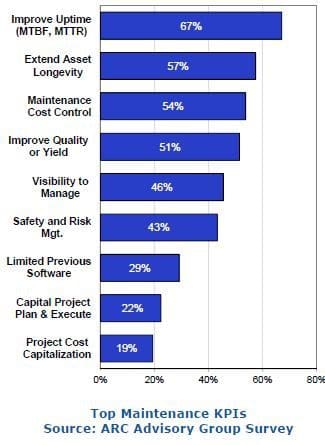Overview
Suppose you’re in logistics for an equipment manufacturer or a maintenance manager in an operating plant, and a geek in your office keeps talking about the Internet of Things (IoT). Here is why you should listen:
- The underlying technologies are available with no needed breakthroughs
- Major companies such as IBM, Cisco, GE have IoT programs with product development and marketing campaigns
- The potential business benefits for OEMs and end users are strong. The technology could help end users improve equipment reliability and reduce spare parts inventories, and help OEMs sell more services at higher margin
By offering IoT-enabled condition monitoring, spare parts, and equipment repair services, equipment OEMs can remotely monitor asset health in their customers’ plants, anticipate failures, order the parts, and often execute repairs before the failure occurs. This provides an ongoing, services-based revenue stream for OEMs, while enhancing customer uptime and overall satisfaction.
Fewer unplanned equipment failures mean the OEM doesn’t have to keep as much spare parts inventory on hand for quick response to emergency repairs. Also, fewer emergency calls mean more spare parts inventory can be in a centrally located warehouse, rather than in regional or local depots.
 Reduced Unplanned Downtime
Reduced Unplanned Downtime
Machine downtime, particularly unplanned downtime, is a key impediment to production performance. Sixty-seven percent of respondents in an ARC survey on Enterprise Asset Management (EAM) cited improved machine uptime as a primary business driver behind purchasing EAM software.
Unplanned downtime causes losses in several areas including:
- Higher costs with work-in-process (WIP) material waste and scrap
- Labor losses with idle time, rework, and clean-up
- Missed production schedules with delayed shipments, customer satisfaction issues, lost orders, and lower revenue
- Higher business risks with potential safety and environmental incidents
The impact of downtime to revenue and profitability gets C-suite attention. Preventing the associated production and financial losses drives maintenance programs, including spare parts inventory and logistics.
IoT and Asset Health Monitoring to Predict Failure
The potential to significantly improve the uptime metric and prevent unplanned downtime through remote asset monitoring provides a significant business value proposition to help justify investments in the IoT and connected devices for both in-plant asset management and field service.
IoT-connected devices enable end users and/or OEMs to remotely monitor sensor data (like vibration, temperature, pressure, etc.). In this manner, the IoT improves product and equipment uptime through remote diagnostics, troubleshooting, and predictive maintenance.
Asset health involves the monitoring of the condition of an asset and detection of an issue before failure occurs. An alert from a health monitoring application notifies a maintenance planner to have someone inspect the equipment and schedule the repair prior to a failure. This has significant impact on the maintenance function:
- Lower repair costs – A failure of a component cascades into a much larger issue. For example if your car engine runs out of oil, the bearings will seize and the engine will have to be replaced. In this case, $25 dollars worth of oil cascades into a $5,000 repair.
- Less inventory – Much of the spare parts inventory exists “just in case,” so equipment can be repaired quickly to re-start production. With predictability, time becomes available to order and obtain the parts.
New Revenue for Equipment Manufacturers
IoT emphasizes remote access to connected machines to enable transformative business improvements – one of which is field service by original equipment manufacturers (OEM). With IoT, the value of an OEM’s service plan greatly improves – more uptime and less unplanned downtime for the user of the equipment.
Remote device connectivity coupled with device-level service apps help manufacturers more rapidly diagnose and troubleshoot issues in the field, address them in a more timely fashion, and market new subscription-based products and services. This is the strategy behind GE’s “Industrial Internet.”
With the credible and clear improved uptime benefits, OEMs have the opportunity to raise prices and sell more services. The improved margin and new revenue opportunities provide the financial incentives that will drive many OEMs to adopt IoT solutions. A post on new revenue with IoT for OEMs is here.
Impact on Logistics and the Spare Parts Supply Chain
Currently, many spare parts supply chains are constructed in such a manner that inventory is held centrally, perhaps in a manufacturing plant or a centrally located warehouse in a particular region. This central stocking location sends inventory to a network of depots that can provide a quick response to customers’ needs. Often, warehousing and shipping services are outsourced to a third-party logistics (3PL) service provider, particularly the large 3PLs that have specialized in parcel deliveries (FedEx, DHL, TNT, UPS,) and have an infrastructure in place to respond quickly.
Some types of spare parts are not critical in the sense the customer will not lose substantial amounts of money for downtime if the delivery is delayed a few days. An example would be automotive parts or large household appliances parts. However, the ability to deliver quickly to local dealers is a competitive advantage for the manufacturer.
For critical spare parts (such as expensive parts used in production machinery), the customer may have a service contract that requires delivery within a set time period after a service failure occurs. Customers pay more if they require very quick service within a few hours of a part failure. The customer may also pay to install the spare part. If installation services are required, the local depot serving that customer is more likely to be run by the manufacturer, rather than a 3PL.
Clearly if the customer is using a “run to failure” maintenance strategy, which is often the case, the pressure for a satellite depot to respond quickly after a part failure is greatly increased. Critical parts absolutely need to be in inventory in the local depot for the OEM to be able to respond within a few hours.
For less critical parts, it is often impossible for OEMs to store all inventory locally. In automotive, for example, customers may have cars that are decades old, involving potentially hundreds of thousands of different parts. To support dealers, OEMs would have to use expensive overnight shipments from the central warehouse directly to the dealer or to the depots that support the dealer network.
In the future, as parts become intelligent and connected — enabling failures to be predicted days or even weeks in advance — OEMs will be able to reduce the amount of spare parts inventory they need to hold both centrally and in local depots, since the central site will be responding to planned maintenance, not crises. OEMs will have more opportunities to consolidate shipments to depots and switch to slower and less expensive transportation modes. In short, remote condition monitoring of connected devices and equipment through IoT will allow OEMs to improve customer service while reducing their own costs.
Recommendations
Listen to your “inner geek,” and consider the potential impact of the Internet of Things on your business
- For OEMs, consider the broader benefits of IoT beyond revenue enhancement for services, and examine the optimization of inventory and depots for additional business improvements
- For end-users, include IoT, remote monitoring, and predictive maintenance in the selection criteria for new equipment to reduce total lifecycle cost




















